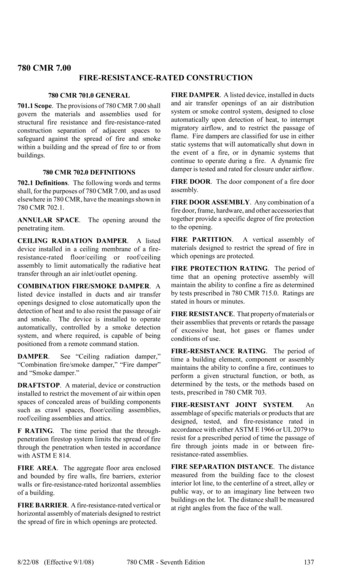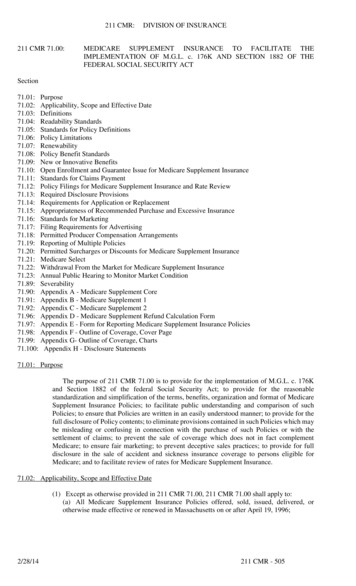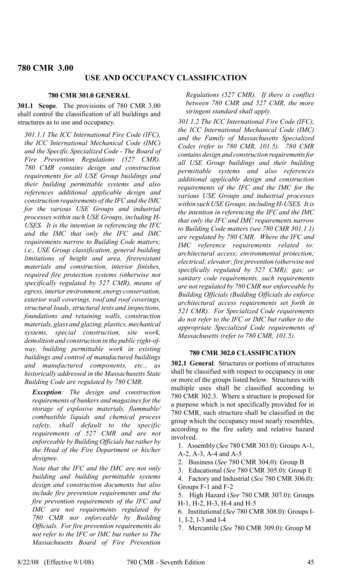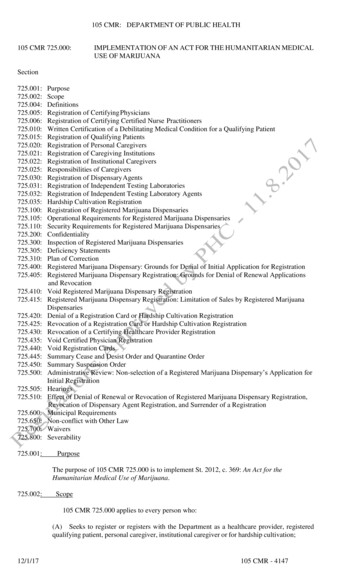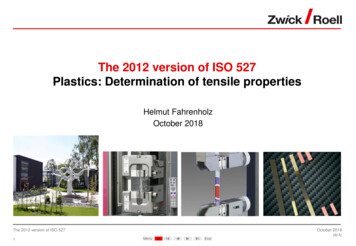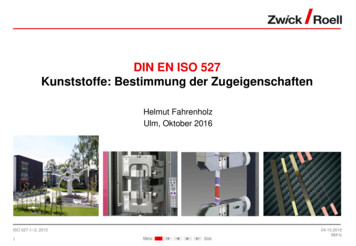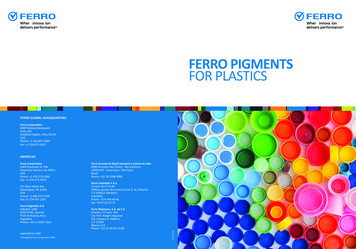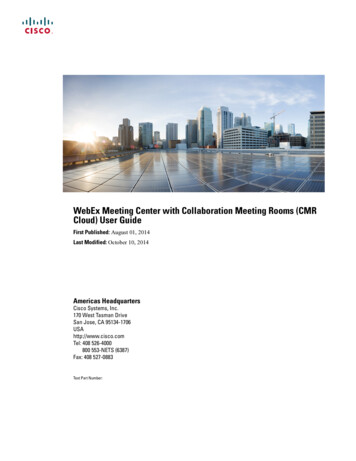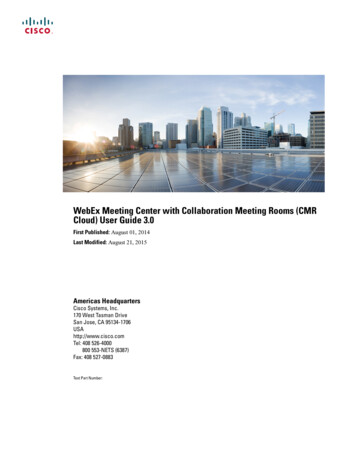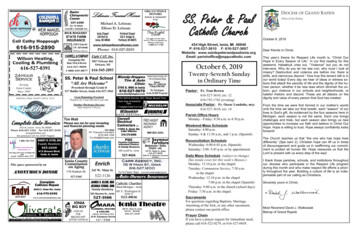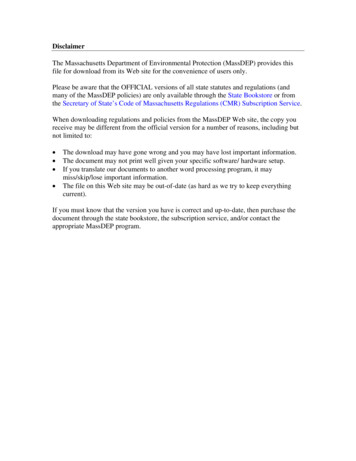
Transcription
DisclaimerThe Massachusetts Department of Environmental Protection (MassDEP) provides thisfile for download from its Web site for the convenience of users only.Please be aware that the OFFICIAL versions of all state statutes and regulations (andmany of the MassDEP policies) are only available through the State Bookstore or fromthe Secretary of State’s Code of Massachusetts Regulations (CMR) Subscription Service.When downloading regulations and policies from the MassDEP Web site, the copy youreceive may be different from the official version for a number of reasons, including butnot limited to: The download may have gone wrong and you may have lost important information.The document may not print well given your specific software/ hardware setup.If you translate our documents to another word processing program, it maymiss/skip/lose important information.The file on this Web site may be out-of-date (as hard as we try to keep everythingcurrent).If you must know that the version you have is correct and up-to-date, then purchase thedocument through the state bookstore, the subscription service, and/or contact theappropriate MassDEP program.
527 CMR: BOARD OF FIRE PREVENTION REGULATIONS527 CMR 9.00:TANKS AND CONTAINERSSection9.01: Purpose and Scope9.02: Definitions9.03: Aboveground Storage Tanks Greater Than 10,000 Gallons Capacity or Tanks StoringCombustible Liquids9.04: Aboveground Storage Tanks Equal to or Less Than 10,000 Gallons Capacity For Storing Class ILiquids9.05: Underground Storage Tanks9.06: Waste Oil Storage Tanks9.07: General Provisions9.08: Referenced Publications9.01: Purpose and Scope(1) 527 CMR 9.00 shall apply to the design, construction, installation, testing, and maintenanceof tanks and containers. The intent is to protect the public safety and welfare from the dangersof fire and/or explosion due to tank or container leakage of flammable and combustible liquids.(2) Aboveground tanks of more than 10,000 gallons capacity for the storage of any fluid otherthan water shall be regulated by 527 CMR 9.00 and by 502 CMR 5.00: Permit RequirementsAnd Annual Inspection Of Aboveground Storage Tanks Or Containers Of More Than TenThousand Gallons’ Capacity for the purpose of protecting the public safety and welfare from thedangers of tank failure, rupture, or leakage. In the event of a conflict between 527 CMR 9.00or any other requirement in 527 CMR or 502 CMR 5.00 or 780 CMR (The State Building Code),the more stringent of the aforementioned regulations shall apply.(3) 527 CMR 9.00 shall apply to the design, construction, installation, testing and maintenanceof tanks storing hazardous substances.(4) Nothing in 527 CMR 9.00 shall be construed to abrogate the provisions of 780 CMR, TheState Building Code, which may contain additional requirements for the design, construction,and installation of aboveground storage tanks.9.02: DefinitionsFor the purposes of 527 CMR 9.00, the following terms shall have the meanings assigned tothem:Abandoned, in the case of underground storage tanks, shall mean out of service for a continuousperiod in excess of six months and for a period in excess of 24 months in the case of anyaboveground tank of 10,000 gallons capacity or less; and in the case of aboveground storage ofany fluid other than water, where a permit is required from the Marshal under provisions ofM.G.L. c. 148, § 37, it shall mean out of service for a continuous period in excess of 60 monthsand it has been deemed to be unsafe and a threat to the public safety by the Head of the FireDepartment and by the Department of Fire Services.Aboveground Storage Tank. A horizontal or vertical tank, that is listed and intended for fixedinstallation, without back fill above or below grade, and is used within the scope of its approvalor listing.EXCEPTION 1: Aboveground Storage Tanks regulated by 527 CMR 9.04: Vaults, and 502CMR 5.00: Permit Requirements And Annual Inspection Of Aboveground Storage Tanks OrContainers Of More Than Ten Thousand Gallons’ Capacity need not meet double-walled tankrequirements.
527 CMR: BOARD OF FIRE PREVENTION REGULATIONS9.02: continuedEXCEPTION 2: Aboveground pressure vessels constructed in accordance with the requirementsof the ASME, Unfired Pressure Vessels Code and regulated by M.G.L. c. 146 and 527 CMR9.07(G) shall be exempt from the requirements for vaults or double-walled tanks.Approved, approved by the State Fire Marshal.Automatic Line Leak Detector, a device designed to detect product or pressure losses in apressurized product line of a remote pumping system.Board, the Board of Fire Prevention Regulations.Cathodic Protection System, a technique which inhibits the corrosion of a tank or its componentseither through sacrificial or galvanic anodes or impressed current.Class A Operator, means the individual or individuals designated by the owner or operator tohave primary statutory and regulatory responsibility for the operation and maintenance of theunderground storage tank system. The Class A Operator may hold more than one class ofoperator position.Class B Operator, means the individual or individuals designated by the owner or operator toimplement applicable regulatory requirements and implement the daily aspects of the operation,maintenance, and recordkeeping for the underground storage tank system. The Class B Operatormay hold more than one class of operator position.Class C Operator, means the individual or individuals designated by the owner or operator tohave primary responsibility for responding to alarms, emergencies presented by spills or releases,and other problems associated with the operation of the underground storage tank system. TheClass C Operator may hold more than one class of operator position.Combustible Liquid, Any liquid having a flash point at or above 100 F shall be known as a ClassII or Class III Liquid. Combustible liquids shall be divided into the follClass II: Liquids having flash points at or above 100 F. and below 140 F.Class IIIA: Liquids having a flash point at or above 140 F. and below 200 F.Class IIIB: Liquids having a flash point at or above 200 F.Components, piping, pumps, and other related storing, conveyancing, and dispensing elementswhich, together with one or more tanks and any cathodic protection or monitoring system,constitute a storage facility.Consumptive Use, fuel oil used exclusively for area heating and/or the heating of domestic wateron the premises where stored.Corrosion Expert, a person who, by reason of thorough knowledge of the physical sciences andthe principles of engineering and mathematics acquired by a professional education and relatedpractical experience, is qualified to engage in the practice of corrosion control on buried orsubmerged metal piping systems and metal tanks. Such person shall be accredited or certifiedas being qualified by the National Association of Corrosion Engineers (NACE) as a CathodicProtection Specialist or Corrosion Specialist or be a Massachusetts registered professionalcorrosion engineer. The corrosion expert shall follow applicable NACE criteria.DEP, The Massachusetts Department of Environmental Protection.Department, the Department of Fire Services.
527 CMR: BOARD OF FIRE PREVENTION REGULATIONS9.02: continuedDouble-walled Tank, a container with two complete shells which provide both primary andsecondary containment. The container shall have a continuous 360 interstitial space betweenthe primary and secondary shell. The interstitial space shall be designed with an approvedinterstitial space monitor to continuously monitor this space. All double-walled tanks shall beUL-listed.Engineer, a Massachusetts registered professional engineer.European Suction System, an underground suction piping system which is sloped back to thetank so that the contents of the piping will drain back into the tank if the suction is released, andonly one check valve is used which is located directly under the dispenser.Existing Facility, a facility whose construction, installation, or operation began prior to theeffective date of the revised edition of 527 CMR 9.00 printed and effective December 31, 1986.Fire Resistant Tank. A tank assembly that consists of a listed aboveground storage tank andconstruction that provides fire resistive protection from exposure to a high intensity liquid poolfire. (See 527 CMR 9.04.)
527 CMR: BOARD OF FIRE PREVENTION REGULATIONSNON-TEXT PAGE
527 CMR: BOARD OF FIRE PREVENTION REGULATIONS9.02: continuedFlammable Liquid, Any liquid having a flash point below 100 F and having a vapor pressure notexceeding 40 psia at 100 F Flammable liquids shall be known as Class I liquids and shall bedivided into the following classifications:Class IA: Liquids having flash points below 73 F and having a boiling point below 100 F.Class IB: Liquids having flash points below 73 F and having a boiling point at or above100 F.Class IC: Liquids having flash points at or above 73 F and below 100 F.Fuel Oil, any hydrocarbon oil as specified by ASTM Standard D396-90, Specification for FuelOil.Hazardous Substances, are regulated substances as defined in section 101(14) of the FederalComprehensive Environmental Response, Compensation and Liability Act of 1980 and 40 CFRPart 302. (This term does not include any substance regulated as a hazardous waste underSubtitle C of the Federal Resource Conservation and Recovery Act and 40 CFR Part 261).Head of the Fire Department, the fire chief or other top ranking official of the local firedepartment, or a designee of the Head of the Fire Department.Interim Wellhead Protection Area (IWPA) for public water systems using wells or well fieldsthat lack a Department of Environmental Protection (Massachusetts DEP) approved Zone II, theDEP will apply an interim wellhead protection area. This IWPA shall be ½-mile radiusmeasured from the well or well field for sources whose approved pumping rate is 100,000gallons per day or greater. For wells or well fields that yield less than 100,000 gallons per day,the IWPA radius is proportional to the approved pumping rate which may be calculatedaccording to the following equation: IWPA radius in feet [32 x pumping rate in gallons perminute] 400.A default IWPA radius shall be applied to transient non-community (TNC) and non-transientnon-community (NTNC) wells for which radii could not be calculated using the above equationbecause there is no metered rate of withdrawal or no approved pumping rate or to wells forwhich there are no DWS-determined radii using other appropriate methods. The default IWPAradius shall be 500 feet for TNC wells and 750 feet for NTNC wells.Leakage or Leak, any uncontrolled movement of product from an above ground storage tankand/or associated piping, either observed or detected, or from an underground storage tanksystem when using a tightness test method, measurable by a final or precision test which canaccurately detect a leak of 0.10 gallons per hour with the probability of detection of 0.95, and theprobability of false alarm of 0.05; or when using a continuous monitoring system which canaccurately detect a leak of 0.20 gallons per hour with the probability of detection of 0.95 and theprobability of false alarm of 0.05.Listed, equipment or materials included in a list published by an organization acceptable to theMarshal, and concerned with product evaluation, that maintains periodic inspection ofproduction of listed equipment or materials and whose listing states either that equipment ormaterials meet appropriate standards or have been tested and found suitable for use in a specificmanner.Marshal, the State Fire Marshal or a designee of the State Fire Marshal.Monitoring System. A full-time system installed for the purpose of early detection of leaks, suchas observation wells, visual or audible alarms, statistical inventory reconciliation (SIR) processconducted in connection with an in-tank monitoring system, or their equivalent. Minimumstandards of monitoring systems shall detect a leak at a minimum rate of 0.20 gallons per houror more with the probability of detection of 0.95, and the probability of false alarm of 0.05.NFPA 30, National Fire Protection Association Standard 30 entitled: Flammable andCombustible Liquids Code, 2003 Edition.
527 CMR: BOARD OF FIRE PREVENTION REGULATIONS9.02: continuedNationally Recognized Testing Laboratory (NRTL). An organization which tests for safety andlists, labels or accepts equipment or materials and which meets the criteria in 527 CMR 49.00(Appendix C).Observation Well, a dug or drilled cased well which can be used for detecting the presence offlammable or combustible liquids, which is drilled to a depth intercepting the water table andscreened as to intercept said water table, and which is installed and maintained in an approvedmanner.Operator, the lessee of a storage facility, or the person or persons responsible for the dailyoperation of a storage facility.Out of Service, not in use in that no filling or withdrawal is occurring.Owner, the person or persons or government entity having legal ownership of a storage facility.Person, any agency or political subdivision of the Federal Government or the Commonwealthof Massachusetts; any state, public or private corporation or authority, individual, trust, firm,joint stock company, partnership, association, consortium, joint venture, or other commercialentity; and any officer, employee or agent of said person, and any group of said persons.Pipeline, any trunk pipeline within the Commonwealth for the transportation of flammable orcombustible liquids.p.s.i., pounds per square inch gauge.Qualified Person, a representative certified by the manufacturer of the product being installedor tested.Remote Pumping System, a pressurized product line system in which flammable andcombustible liquids are supplied to a point away from the tank by means of a pumping unit.Replacement and Substantial Modification, both mean the construction of any additions to anexisting storage facility, the removing of any part of an existing storage facility (e.g., a tank, orpiping) and the installing of a new part, or any restoration, refurbishment, or renovation whichsignificantly impairs or affects the physical integrity of the storage facility or its monitoringsystem.Secondary Containment or Equivalent Protection, techniques that may include impervious liners,double-walled tanks, or equivalent methods approved by the Marshal.Sole Source Aquifer, an aquifer designated by the U.S. Environmental Protection Agency as thesole or principal source of drinking water for an area as defined in 310 CMR 40.0006.Statistical Inventory Reconciliation (SIR), a process of evaluating the various sources of errorspresent in daily inventory records and capable of detecting a leak or discharge from the tanksystem, including associated piping of 0.20 gallons per hour with the probability of detection of0.95 and probability of false alarm of 0.05 as determined by an independent testing laboratoryusing the U.S. Environmental Protection Agency’s standardized test procedures or equivalent.Storage Facility, one or more tanks at a particular site, together with all components thereof, usedor designed to be used for the storage of any product within the scope of 527 CMR 9.01.Tank, any structure either underground or aboveground used or designed to be used for thestorage of any product within the scope of 527 CMR 9.00; as well as any aboveground structurein excess of 10,000 gallons capacity used or designed to be used for the storage of any fluidexcept water.Third-party Inspection, any inspection conducted by or under the direct supervision of a Thirdparty Inspector, in accordance with 527 CMR 9.07(P).
527 CMR: BOARD OF FIRE PREVENTION REGULATIONS9.02: continuedThird-party Inspector, a person who has completed training required by the Marshal and who isa Massachusetts Registered Professional Engineer, a Massachusetts Licensed Site Professional,or a person holding an underground storage tank inspector certification issued by an independentorganization such as: the International Code Council, National F
527 CMR 9.00: TANKS AND CONTAINERS . Section . 9.01: Purpose and Scope 9.02: Definitions 9.03: Aboveground Storage Tanks Greater Than 10,000 Gallons Capacity or Tanks Storing Combustible Liquids 9.04: Aboveground Storage Tanks Equal to or Less Than 10,000 Gallons Capacity For Storing Class I Liquids 9.05: Underground Storage Tanks 9.06:
